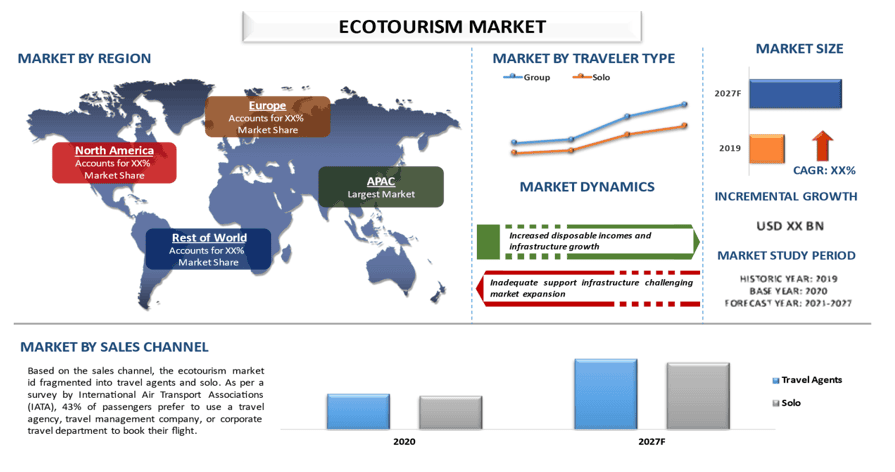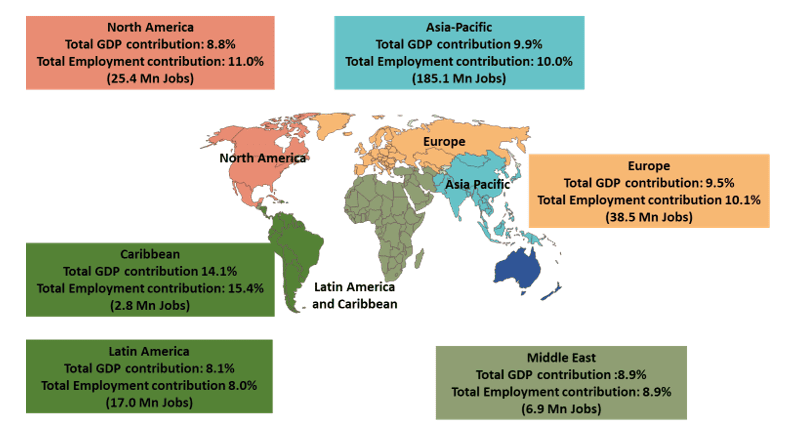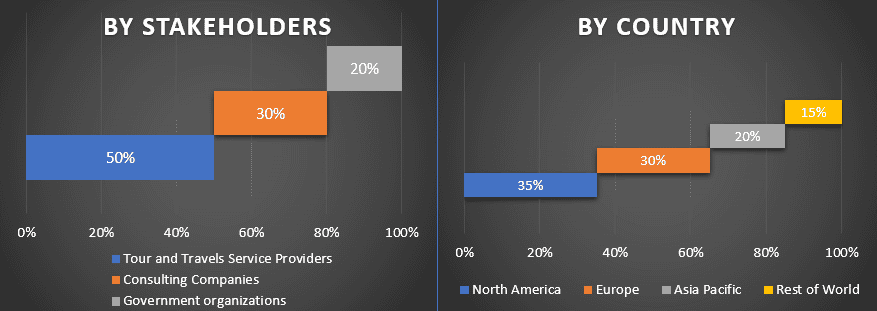
전 세계 에코투어리즘 시장은 예측 기간(2021-2027) 동안 높은 연평균 성장률을 보일 것으로 예상됩니다.
전 세계적으로 증가하는 개인 여행객 수, 가처분 소득 증가 등으로 인해 부상하는 관광 산업은 에코투어리즘 시장 성장에 기여하고 있습니다. 세계여행관광협회에 따르면 아시아 태평양 관광 산업은 2021년 GDP의 약 9.8%인 3조 2,943억 달러를 기여했습니다. 게다가 에코투어리즘에 대한 정부의 계획은 산업 성장의 촉매제 역할을 하고 있습니다. 예를 들어, 2020년에 말레이시아는 에코투어리즘에 집중하고 미래의 재난에 대비하며 코로나바이러스 팬데믹으로 인해 올해 1,000억 링깃(246억 1,000만 달러) 이상을 잃은 것으로 추정되는 침체된 관광 부문을 재개하기 위한 10년 계획을 시작했습니다. 또한 2022년에 인도 환경부는 잠재적인 생태 관광지 90곳의 목록을 발표했습니다. 또한, 에코투어리즘은 중국인들에게 선호되는 선택이 되고 있습니다. 그들은 이제 음이온이 풍부할 뿐만 아니라 짙은 숲과 풍부한 초목이 있는 곳을 방문하는 것을 선호합니다. 중국 동부 저장성의 생태환경부는 사람들의 다양한 생태관광 상품에 대한 증가하는 수요를 충족하기 위해 21개의 생태관광지로 구성된 "생태관광 지도"를 공개했습니다.
또한, 에코투어리즘은 중국인들에게 선호되는 선택이 되고 있습니다. 그들은 이제 음이온이 풍부할 뿐만 아니라 짙은 숲과 풍부한 초목이 있는 곳을 방문하는 것을 선호합니다. 중국은 세계에서 가장 인기 있는 여행지 중 하나가 되었습니다. UNWTO 세계 관광 순위는 중국을 세계에서 세 번째로 많이 방문한 국가로 평가합니다. 2015년에는 중국 본토에서 하룻밤을 묵는 5,560만 명의 외국인 방문객이 몰려들었습니다. 이 방문객들은 주로 관광과 레저 활동을 위해 중국에 오고 있습니다. 중국 환경보호부 또는 MEP는 2,541개의 자연 보호 구역이 1억 4,700만 헥타르 또는 중국의 14.7%를 차지한다고 밝혔습니다. 이러한 보호 구역의 80%에는 어떤 형태로든 에코투어리즘이 있습니다. 풍부한 자연 경관과 특징을 지닌 중국은 관광객들이 갈망하는 아름다운 자연 경관을 가지고 있습니다.
GDP에 대한 여행 및 관광의 총 기여도(USD Bn) 및 고용에 대한 여행 및 관광의 총 기여도, 2019

Adventure Alternative Ltd, Arcari Travel, Frosch International Travel, Inc, G Adventures, Intrepid Group Limited, Rickshaw Travel Group, Small World Journeys Pty Ltd, Steppes Travel Ltd, Travel Leaders Group, Llc, Undiscovered Mountains Ltd 등이 에코투어리즘 시장에서 활동하는 주요 업체입니다. 이러한 업체들은 혁신적인 제품으로 고객을 용이하게 하기 위해 파트너십과 함께 여러 M&A를 수행했습니다.
보고서에 제시된 통찰력
“여행자 유형 중 그룹 부문이 주요 시장 점유율을 차지할 것입니다.”
여행자 유형에 따라 시장은 개인 및 그룹으로 세분화됩니다. 그룹 부문은 주요 시장 점유율을 차지했으며 2020년에 시장을 지배했습니다. 전 세계적으로 부상하는 관광 회사의 수는 개인 부문의 성장으로 이어지고 있습니다. 인도 관광부에 따르면 인도에는 902개의 여행사가 있습니다. 개인 여행자 부문은 예측 기간 동안 더 높은 연평균 성장률로 성장할 것으로 예상됩니다. 혼자 여행하고 싶어하는 사람들이 크게 증가했으며, 이는 여행사와 여행사가 단체 여행객뿐만 아니라 혼자 여행하는 사람들을 위한 시설도 제공하도록 장려했습니다.
“연령대 중 Y세대가 2020년에 시장을 지배했습니다.”
연령대에 따라 시장은 X세대, Y세대 및 Z세대로 세분화됩니다. Y세대 부문은 2020년에 지배적인 시장 점유율을 차지했습니다. 외무부에 따르면 Y세대 또는 밀레니얼 세대 여행객은 이미 유럽의 전체 여행 지출의 약 40%를 차지하는 거대한 시장을 제공합니다. 그러나 Z세대는 향후 몇 년 동안 더 높은 연평균 성장률을 보일 것으로 예상됩니다.
“판매 채널 중 여행사 부문이 향후 몇 년 동안 시장을 지배할 것입니다.”
판매 채널에 따라 시장은 여행사와 직접으로 세분화됩니다. 여행사 부문은 2020년에 지배적인 시장 점유율을 차지했습니다. 노동통계국에 따르면 2021년 5월 현재 미국에는 37,190명의 여행사가 있습니다. 전 세계적으로 여행사 수가 합쳐지면서 이 부문의 점유율이 증가하고 있습니다.
“아시아 태평양은 에코투어리즘 시장의 가장 큰 시장 중 하나를 대표합니다.”
에코투어리즘 시장의 시장 채택에 대한 더 나은 이해를 위해 시장은 북미(미국 및 캐나다), 유럽(독일, 프랑스, 이탈리아, 스페인, 영국 및 기타 유럽), 아시아 태평양(중국, 일본, 인도, 호주 및 기타 APAC) 및 기타 지역과 같은 국가에서 전 세계적으로 존재감을 기반으로 분석됩니다. 아시아 태평양 지역은 에코투어리즘 시장 산업의 주요 시장을 장악했습니다. 그러나 북미 지역은 향후 몇 년 동안 상당한 연평균 성장률을 보일 것입니다.
이 보고서를 구매해야 하는 이유:
- 이 연구에는 인증된 주요 산업 전문가가 검증한 시장 규모 측정 및 예측 분석이 포함되어 있습니다.
- 이 보고서는 전체 산업 성과에 대한 빠른 검토를 한눈에 제공합니다.
- 이 보고서는 주요 비즈니스 재무, 제품 포트폴리오, 확장 전략 및 최근 개발에 중점을 두고 주요 산업 동료에 대한 심층 분석을 다룹니다.
- 산업에서 널리 퍼져있는 동인, 제약, 주요 추세 및 기회에 대한 자세한 조사
- 이 연구는 다양한 부문에 걸쳐 시장을 포괄적으로 다룹니다.
- 산업에 대한 심층적인 지역 수준 분석
맞춤 설정 옵션:
에코투어리즘 시장은 요구 사항 또는 기타 시장 부문에 따라 추가로 맞춤 설정할 수 있습니다. 이 외에도 UMI는 귀하가 고유한 비즈니스 요구 사항을 가질 수 있음을 이해하므로 귀하의 요구 사항에 완벽하게 맞는 보고서를 얻기 위해 언제든지 저희에게 연락하십시오.
목차
글로벌 생태 관광 시장 분석(2021-2027)을 위한 연구 방법론
생태 관광 시장의 과거 시장 분석, 현재 시장 추정 및 미래 시장 예측은 주요 지역에서 생태 관광에 대한 수요를 창출하고 분석하기 위해 수행된 세 가지 주요 단계였습니다. 과거 시장 수치를 수집하고 현재 시장 규모를 추정하기 위해 철저한 2차 연구가 수행되었습니다. 둘째, 이러한 통찰력을 검증하기 위해 수많은 결과 및 가정을 고려했습니다. 또한 생태 관광 시장의 가치 사슬 전반에 걸쳐 업계 전문가와 함께 철저한 1차 인터뷰도 실시했습니다. 1차 인터뷰를 통해 시장 수치를 가정하고 검증한 후, 전체 시장 규모를 예측하기 위해 상향식/하향식 접근 방식을 사용했습니다. 그 후, 시장 세분화 및 데이터 삼각 측량 방법을 채택하여 관련 산업의 세그먼트 및 하위 세그먼트의 시장 규모를 추정하고 분석했습니다. 자세한 방법론은 아래에 설명되어 있습니다.
과거 시장 규모 분석
1단계: 2차 자료에 대한 심층 연구:
연례 보고서 및 재무제표, 성과 발표, 보도 자료 등과 같은 회사 내부 자료와 저널, 뉴스 및 기사, 정부 간행물, 경쟁사 간행물, 부문 보고서, 타사 데이터베이스 및 기타 신뢰할 수 있는 간행물을 포함한 외부 자료를 통해 생태 관광의 과거 시장 규모를 얻기 위해 자세한 2차 연구를 수행했습니다.
2단계: 시장 세분화:
생태 관광 시장의 과거 시장 규모를 확보한 후, 주요 지역에 대한 여행자 유형, 연령 그룹 및 판매 채널의 과거 시장 통찰력과 점유율을 수집하기 위해 자세한 2차 분석을 수행했습니다. 보고서에 포함된 주요 세그먼트는 연령 그룹 및 판매 채널입니다. 전 세계적으로 생태 관광의 전반적인 채택을 평가하기 위해 추가 지역 및 국가 수준 분석을 수행했습니다.
3단계: 요인 분석:
다양한 세그먼트 및 하위 세그먼트의 과거 시장 규모를 확보한 후, 생태 관광의 현재 시장 규모를 추정하기 위해 자세한 요인 분석을 수행했습니다. 또한 가처분 소득 증가, 숙박 부문에 대한 투자 증가 등과 같은 종속 및 독립 변수를 사용하여 요인 분석을 수행했습니다. 전 세계 생태 관광 산업에서 최고의 파트너십, 합병 및 인수, 사업 확장 및 제품 출시를 고려하여 수요 및 공급측 시나리오에 대한 철저한 분석을 수행했습니다.
현재 시장 규모 추정 및 예측
현재 시장 규모 측정: 위의 3단계의 실행 가능한 통찰력을 바탕으로 현재 시장 규모, 생태 관광 시장의 주요 업체 및 세그먼트의 시장 점유율에 도달했습니다. 필요한 모든 백분율 점유율 분할 및 시장 세분화는 위에서 언급한 2차 접근 방식을 사용하여 결정되었으며 1차 인터뷰를 통해 확인되었습니다.
추정 및 예측: 시장 추정 및 예측을 위해 이해 관계자가 사용할 수 있는 동인 및 추세, 제약 및 기회를 포함한 다양한 요인에 가중치를 할당했습니다. 이러한 요인을 분석한 후 관련 예측 기술, 즉 상향식/하향식 접근 방식을 적용하여 전 세계 주요 시장에서 다양한 세그먼트 및 하위 세그먼트에 대한 2027년 시장 예측에 도달했습니다. 시장 규모를 추정하기 위해 채택된 연구 방법론은 다음을 포함합니다.
- 가치(US$) 측면에서 산업의 시장 규모와 국내 주요 시장에서 생태 관광의 채택률
- 시장 세그먼트 및 하위 세그먼트의 모든 백분율 점유율, 분할 및 세분화
- 제공되는 서비스 측면에서 생태 관광 시장의 주요 업체. 또한 빠르게 성장하는 시장에서 경쟁하기 위해 이러한 업체가 채택한 성장 전략
시장 규모 및 점유율 검증
1차 연구: 주요 지역의 최고 경영진(CXO/VP, 영업 책임자, 마케팅 책임자, 운영 책임자, 지역 책임자, 국가 책임자 등)을 포함한 핵심 오피니언 리더(KOL)와 심층 인터뷰를 실시했습니다. 그런 다음 1차 연구 결과를 요약하고 명시된 가설을 입증하기 위해 통계 분석을 수행했습니다. 1차 연구의 입력은 2차 결과와 통합되어 정보를 실행 가능한 통찰력으로 전환합니다.
다양한 지역의 1차 참가자 분할

시장 엔지니어링
데이터 삼각 측량 기술을 사용하여 전체 시장 추정을 완료하고 생태 관광 시장의 각 세그먼트 및 하위 세그먼트에 대한 정확한 통계 수치에 도달했습니다. 생태 관광 시장의 여행자 유형, 연령 그룹 및 판매 채널 영역에서 다양한 매개변수와 추세를 연구한 후 데이터를 여러 세그먼트 및 하위 세그먼트로 분할했습니다.
생태 관광 시장 조사의 주요 목표
생태 관광의 현재 및 미래 시장 동향은 연구에서 정확히 지적되었습니다. 투자자는 연구에서 수행된 질적 및 양적 분석에 대한 재량에 따라 투자를 기반으로 전략적 통찰력을 얻을 수 있습니다. 현재 및 미래 시장 동향은 지역 수준에서 시장의 전반적인 매력을 결정하여 산업 참가자가 미개척 시장을 활용하여 최초 이동자 이점을 누릴 수 있는 플랫폼을 제공합니다. 연구의 다른 양적 목표는 다음과 같습니다.
- 가치(US$) 측면에서 생태 관광의 현재 및 예측 시장 규모를 분석합니다. 또한 다양한 세그먼트 및 하위 세그먼트의 현재 및 예측 시장 규모를 분석합니다.
- 연구의 세그먼트에는 여행자 유형, 연령 그룹 및 판매 채널 영역이 포함됩니다.
- 생태 관광 산업에 대한 규제 프레임워크 정의 및 분석
- 다양한 중개자의 존재와 관련된 가치 사슬을 분석하고 산업의 고객 및 경쟁사 행동을 분석합니다.
- 주요 국가의 생태 관광 시장의 현재 및 예측 시장 규모를 분석합니다.
- 보고서에서 연구된 주요 지역에는 북미, 유럽, 아시아 태평양 및 기타 지역이 포함됩니다.
- 빠르게 성장하는 시장에서 유지하기 위해 시장 플레이어가 채택한 생태 관광 시장 및 성장 전략의 회사 프로필
- 산업에 대한 심층 지역 수준 분석
관련 보고서
이 상품을 구매한 고객님들도 함께 구매하신 상품










